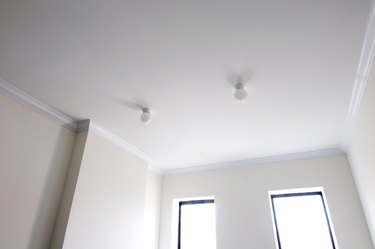
Homeowners often find a variety of bugs inside their homes, especially during the spring and summer months. The attic is a favorite hiding place for many species of insects, and you may discover bugs swarming in your ceiling. Bat bugs, bedbugs and cluster flies are all known to hide in ceilings and attics, coming out only to forage for food.
Types
Video of the Day
Bat bugs are similar to bedbugs, hiding in protected areas and feeding on human blood. These bugs find their way into homes while riding on bats, which are their preferred host. Once bats leave the attic, bat bugs must find another source of food and often move to ceiling moldings. Bat bugs are members of the Cimicidae family and have piercing mouth parts. These pests are flat, oval in shape and become dark red when engorged with blood after a meal. Bedbugs are another bloodsucking pest that is often found living in ceiling moldings, cracks in plaster and in loose wallpaper. These bugs are also members of the Cimicidae family and are almost impossible to differentiate from bat bugs. At night, bedbugs move from ceiling moldings and other hiding places to feed on human blood. Flies are also a problem in many homes throughout the year. Cluster flies are most often seen from fall through spring. Cluster flies enter homes to hibernate and often find their way into attics, inside walls and underneath ceiling moldings. These bugs do not bite or sting humans, but they can become a nuisance when they come out of hiding to swarm indoors.
Video of the Day
Effects
Both bat bugs and bedbugs hide indoors, coming out of their hiding places to feed on human blood. These bugs usually stay close to humans and are often found living in ceiling moldings in bathrooms and bedrooms. Other areas inside the home such as curtains, wooden trim, bedding and picture frames are also favorite hiding spots for these pests. Most people do not feel bat bugs and bedbugs biting them, but the bites can cause intense itching for up to seven days. Cluster flies received their name because they hide in clusters in attics and ceilings. These flies do not reproduce when living indoors and are not considered filth flies. As the weather begins to warm after the winter, cluster flies come out of their hiding places and swarm indoors.
Cultural Control
Eliminating bats in your attic is important in reducing bat bug infestations. Consult your local game and wildlife office for information on how to eliminate bats in your home legally. Inspect your home for cracks, crevices and other areas that can allow bats to enter your attic. Caulk or seal these areas to prevent reinfestation. Finding out where bat bugs and bedbugs are hiding is key to controlling these pests. Remove ceiling molding, wallpaper and electrical outlets, and search for these pests. Dark spots of fecal matter are often seen where bat bugs live. If bedbug populations are high, you may be able to smell a sweet or musty odor inside your home. Remove all infested items from your home, and vacuum the bugs from infested areas if possible. Preventing cluster flies from hibernating inside your attic is an important aspect of controlling infestations. Seal all cracks underneath the eaves of your home to keep them outside where they belong. Once cluster flies are inside your attic or other protected places, they are difficult to control.
Chemical Control
Bat bugs and bedbugs require professional pest control if infestations are heavy. Light infestations of these pests may be controlled by treating the areas where bugs migrate indoors. Spraying residual insecticides around ceiling moldings, light fixtures, door frames and around electrical outlets can help kill these pests. Insecticides must be reapplied every two weeks until the bugs are no longer a problem. Chemical control methods such as foggers or insecticides are not effective in reducing cluster flies because they hibernate in protected areas that are difficult for most people to reach, such as the attic or ceiling. Swatting flies with a fly swatter when they swarm indoors is the most effective form of cluster fly control.